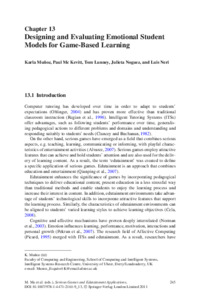Designing and Evaluating Emotional Student Models for Game-Based LearningPaul Mc Kevitt, Tom Lunney, Julieta Noguez, Luis Neri
Zu finden in: Serious Games and Edutainment Applications (Seite 245 bis 271), 2012
|
 |
 Diese Seite wurde seit 6 Jahren inhaltlich nicht mehr aktualisiert.
Unter Umständen ist sie nicht mehr aktuell.
Diese Seite wurde seit 6 Jahren inhaltlich nicht mehr aktualisiert.
Unter Umständen ist sie nicht mehr aktuell.
 Zusammenfassungen
Zusammenfassungen

Research in game-based learning environments aims to recognise and show emotion. This chapter describes the main approaches and challenges involved in achieving these goals. In addition, we propose an emotional student model that can reason about students’ emotions using observable behaviour and responses to questions. Our model uses Control-Value Theory (Pekrun et al., The control value theory of achievement emotions. An integrative approach to emotions in education. In: Schutz, P.A., Pekrun, R. (eds.) Emotion in Education, pp. 13–36. Elsevier, London, 2007) as a basis for representing behaviour and was designed and evaluated using Probabilistic Relational Models (PRMs), Dynamic Bayesian Networks (DBNs) and Multinomial Logistic Regression. Olympia, a game-based learning architecture, was enhanced to incorporate affect and was used to develop PlayPhysics, an emotional game-based learning environment for teaching Physics. PlayPhysics’ design and emotional student model was evaluated with 79 students of Engineering at Tecnológico de Monterrey, Mexico City campus (ITESM-CCM). Results are presented and discussed. Future work will focus on conducting tests with a larger population of students, implementing additional game challenges and incorporating physiological signals to increase the accuracy of classification.
 Dieses Kapitel erwähnt ...
Dieses Kapitel erwähnt ...
 Anderswo finden
Anderswo finden
 Volltext dieses Dokuments
Volltext dieses Dokuments
 |  Designing and Evaluating Emotional Student Models for Game-Based Learning: Artikel als Volltext bei Springerlink ( Designing and Evaluating Emotional Student Models for Game-Based Learning: Artikel als Volltext bei Springerlink ( : :  , 1205 kByte; , 1205 kByte;  : :  ) ) |
 Anderswo suchen
Anderswo suchen 
 Beat und dieses Kapitel
Beat und dieses Kapitel
Beat hat Dieses Kapitel während seiner Zeit am Institut für Medien und Schule (IMS) ins Biblionetz aufgenommen. Beat besitzt kein physisches, aber ein digitales Exemplar. Eine digitale Version ist auf dem Internet verfügbar (s.o.). Aufgrund der wenigen Einträge im Biblionetz scheint er es nicht wirklich gelesen zu haben. Es gibt bisher auch nur wenige Objekte im Biblionetz, die dieses Werk zitieren.










 Emotionen
Emotionen Lernen
Lernen
 Biblionetz-History
Biblionetz-History